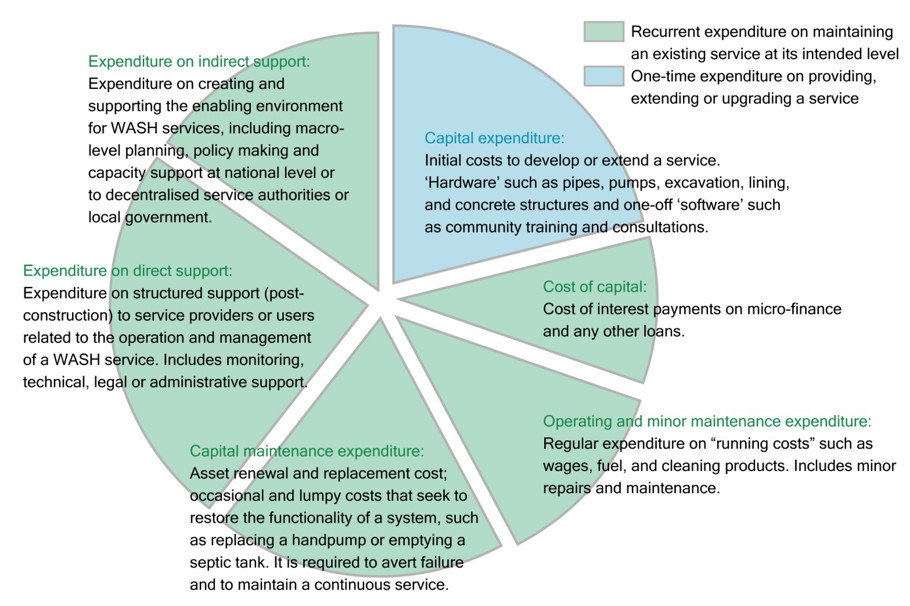Difference between revisions of "Costs of WASH Service Delivery - Introduction"
| Line 6: | Line 6: | ||
Life-cycle costs are divided into six categories (see figure 1 below). These six categories are related to ''onetime expenditures'' on providing or upgrading a service, also known as capital expenditure (in green in figure 1) and ''recurrent expenditures'' (in blue in figure 1) on maintaining a service at its intended level. | Life-cycle costs are divided into six categories (see figure 1 below). These six categories are related to ''onetime expenditures'' on providing or upgrading a service, also known as capital expenditure (in green in figure 1) and ''recurrent expenditures'' (in blue in figure 1) on maintaining a service at its intended level. | ||
| − | [[Image:Costs intro fg 1.jpg|thumb|center|600px|Source: Fonseca, C. et al., 2010b]] | + | [[Image:Costs intro fg 1.jpg|thumb|center|600px|Figure 1. Source: Fonseca, C. et al., 2010b]] |
[[Capital Expenditure (CapEx)|Capital Expenditure (CapEx)]] is the costs of providing a water or sanitation service to users where there was no service before; or of substantially increasing the level of services received by users. It includes the capital invested in the first time construction of water and sanitation systems such as concrete structures, wells, pumps, pipes or toilets prior to implementation of the service. Capital expenditure can also include expenditures to improve or expand existing water or sanitation systems. | [[Capital Expenditure (CapEx)|Capital Expenditure (CapEx)]] is the costs of providing a water or sanitation service to users where there was no service before; or of substantially increasing the level of services received by users. It includes the capital invested in the first time construction of water and sanitation systems such as concrete structures, wells, pumps, pipes or toilets prior to implementation of the service. Capital expenditure can also include expenditures to improve or expand existing water or sanitation systems. | ||
Revision as of 05:23, 11 January 2013
The costs of water, sanitation and hygiene services include expenditure on construction of water and sanitation systems, operation and maintenance and eventual rehabilitation of infrastructure. It also includes training and support to service providers, cost of capital, and expenditures for monitoring, planning and policy making. They are often referred to as life-cycle costs; the costs of delivering water, sanitation and hygiene services indefinitely to a specific population in a particular geographic area.
Life-cycle costs are divided into six categories (see figure 1 below). These six categories are related to onetime expenditures on providing or upgrading a service, also known as capital expenditure (in green in figure 1) and recurrent expenditures (in blue in figure 1) on maintaining a service at its intended level.
Capital Expenditure (CapEx) is the costs of providing a water or sanitation service to users where there was no service before; or of substantially increasing the level of services received by users. It includes the capital invested in the first time construction of water and sanitation systems such as concrete structures, wells, pumps, pipes or toilets prior to implementation of the service. Capital expenditure can also include expenditures to improve or expand existing water or sanitation systems.
Recurrent expenditures consist of the following categories of expenditures:
Operations and minor maintenance expenditure (OpEx) covers the costs for operating and maintaining water and sanitation systems such as labour, fuel, electricity, chemicals, cleaning products for latrines etc.
Capital maintenance expenditure (CapManEx) is the cost of replacement or rehabilitation of water and sanitation infrastructure in order to keep service delivery on-going.
Cost of capital (CoC) is the expense of financing a programme or project and includes interest on loans and the cost of tying up scarce capital. In the case of private sector investment, the cost of capital includes what should be a ‘fair profit’, to be distributed as dividends.
Expenditure on direct support (ExpDS) includes expenditure on post-construction activities directed at local stakeholders, users or user groups. It is the costs of ensuring local government staff have the capacity and resources to repair broken systems and monitor service delivery.
Expenditure on indirect support (ExpIDS) includes government national level planning and policy making, plus developing and maintaining frameworks and institutional arrangements and capacity building for professionals and technicians. Expenditures on indirect support are not tied to a particular programme or project.
Examples
World Bank-RWSN Webinar life-cycle costing
In this webinar on life-cycle costing, Catarina Fonseca, IRC senior Programme Officer and the WASHCost project director, explains the life-cycle cost components. This webinar was part of the World Bank-RWSN Webinar 7, May 15 2012).
Cost benchmarks
Based on research from the WASHCost project, the one-time capital expenditure for preparing and installing a borehole and handpump (at 2011 prices) range from US$ 20 per person to just over US$ 60 per person (see table 1). For small piped schemes, including mechanised boreholes, benchmark costs range from US$ 30 to just over US$ 130 per person. For intermediate and larger schemes benchmark capital costs vary widely from US$ 20 to US$ 152 per person. Recurrent costs benchmarks range from US$ 3 to US$ 6 per person per year for boreholes and handpumps, and from US$ 3 to US$ 15 per person per year for piped schemes.

